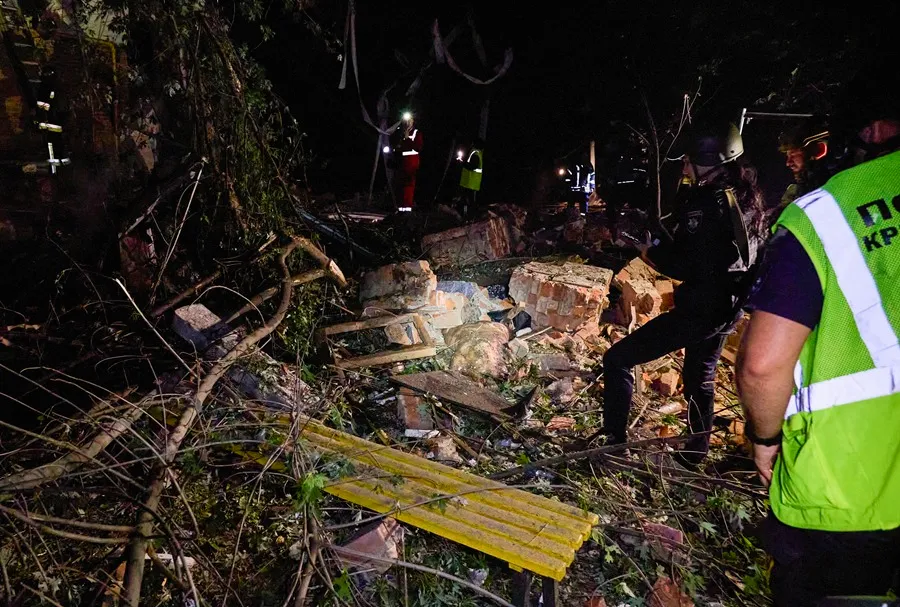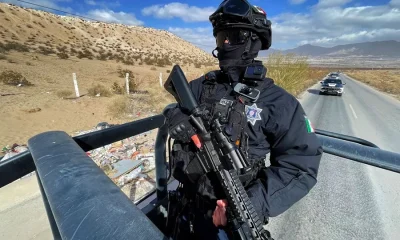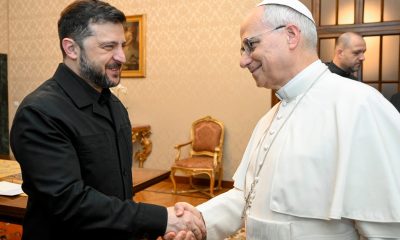International
Ukraine launches counterattacks in Kharkov while trying to contain the Russian attacks in Donetsk

Ukrainian troops defending the north of the Kharkov region are counterattacking after managing to stop the Russian advance in the area near the Russian-Ukrainian border.
Meanwhile, Russian forces remain pressured on different segments of the front in the eastern region of Donetsk and also in the south.
“The fighting continues near Liptsi and between Gliboke and Lukiantsi, as well as the assaults near and inside Vovchansk,” reads the latest bulletin of the Center for Defense Strategies in Kiev, which also states that “the Armed Forces of Ukraine counterattacked near Vovchansk and Staritsia.”
All these localities are located on the two axes opened by Russia in the cross-border offensive that its troops launched in the middle of last month against the Kharkov Oblast, which is still subjected to constant Russian airstrikes that hit the homonymous regional capital with special hard.
Meanwhile, the Institute for the Study of War (ISW) in Washington collects in its report this Monday “recent” Russian advances “near Vovchansk” and in the surroundings of the occupied cities of Avdivka and Donetsk, capital of the homonymous region of eastern Ukraine.
The ISW has also confirmed a Russian “marginal” advance in the town of Krinki, located on the eastern shore of the Dnipro River in the southern region of Kherson. Ukraine has established on that margin of the final stretch of the river a beachhead that Russia is trying to destroy with constant attacks.
The pressure that Russia continues to exert on the entire front is accompanied by a very high number of casualties, according to the daily balances offered by the Ukrainian General Staff.
In the past 24 hours alone, Russian forces recorded, between dead and wounded, 1,270 casualties of soldiers along the contact line. Until the opening of a new front in Kharkov last month, the number of Russian casualties did not usually cross the threshold of a thousand, something that now happens practically daily.
Regarding the losses of military material, Ukraine managed to destroy 14 enemy tanks and 47 artillery systems during the last day.
Kiev hopes to be able to completely stabilize the front with the new US aid in weapons and ammunition that it began to receive weeks ago.
More than a dozen allies have confirmed in recent days that they will allow Ukraine to hit military targets located in the territory of the Russian Federation, which could enable Ukraine to neutralize in origin many of the attacks that the Russians launch from their own territory against border regions such as Kharkov.
International
U.S. and Mexico Reach Deal to Address Water Deficit Under 1944 Treaty

The United States and Mexico have reached an agreement to comply with current water obligations affecting U.S. farmers and ranchers and for Mexico to cover its water deficit to Texas under the 1944 Water Treaty, the U.S. Department of Agriculture said in a statement.
The department уточified that the agreement applies to both the current cycle and the water deficit from the previous cycle.
On Monday, U.S. President Donald Trump accused Mexico of failing to comply with the water-sharing treaty between the two countries, which requires the United States to deliver 1.85 billion cubic meters of water from the Colorado River, while Mexico must supply 432 million cubic meters from the Rio Grande.
Mexico is behind on its commitments. According to Washington, the country has accumulated a deficit of more than one billion cubic meters of water over the past five years.
“This violation is severely harming our beautiful crops and our livestock in Texas,” Trump wrote on Monday.
The Department of Agriculture said on Friday that Mexico had agreed to supply 250 million cubic meters of water starting next week and to work toward closing the shortfall.
Agriculture Secretary Brooke Rollins, quoted in the statement, said Mexico delivered more water in a single year than it had over the previous four years combined.
Trump has said that if Mexico continues to fall short of its obligations, the United States reserves the right to impose 5% tariffs on imported Mexican products.
Mexico’s Deputy Foreign Minister for North America, Roberto Velasco, said that a severe drought in 2022 and 2023prevented the country from meeting its commitments.
International
Several people shot in attack on Brown University campus

Several people were shot on Saturday in an attack on the campus of Brown University, in the northeastern United States, local police reported.
“Shelter in place and avoid the area until further notice,” the Providence Police Department urged in a post on X. Brown University is located in Providence, the capital of the state of Rhode Island.
U.S. President Donald Trump said on his social media platform Truth Social that he had been briefed on the situation and that the FBI was on the scene.
At 5:52 p.m. local time (11:52 p.m. GMT), Brown University said the situation was still “ongoing” and instructed students to remain sheltered until further notice.
After initially stating that the suspect had been taken into custody, Trump later posted a second message clarifying that local police had walked back that information. “The suspect has NOT been apprehended,” the U.S. president said.
International
Colombia says it would not reject Maduro asylum request as regional tensions escalate

The Colombian government stated on Thursday that it would have no reason to reject a potential asylum request from Venezuelan President Nicolás Maduro should he leave office, as regional tensions persist over the deployment of U.S. military forces in the Caribbean since August.
“In the current climate of tension, negotiations are necessary, and if the United States demands a transition or political change, that is something to be assessed. If such a transition results in him (Maduro) needing to live elsewhere or seek protection, Colombia would have no reason to deny it,” said Colombian Foreign Minister Rosa Villavicencio in an interview with Caracol Radio.
However, Villavicencio noted that it is unlikely Maduro would choose Colombia as a refuge. “I believe he would opt for someplace more distant and calmer,” she added.
Colombian President Gustavo Petro also commented on Venezuela’s situation on Wednesday, arguing that the country needs a “democratic revolution” rather than “inefficient repression.” His remarks followed the recent detention and passport cancellation of Cardinal Baltazar Porras at the Caracas airport.
“The Maduro government must understand that responding to external aggression requires more than military preparations; it requires a democratic revolution. A country is defended with more democracy, not more inefficient repression,” Petro wrote on X (formerly Twitter), in a rare public criticism of the Venezuelan leader.
Petro also called for a general amnesty for political opponents and reiterated his call for forming a broad transitional government to address Venezuela’s prolonged crisis.
Since September, U.S. military forces have destroyed more than 20 vessels allegedly carrying drugs in Caribbean and Pacific waters near Venezuela and Colombia, resulting in over 80 deaths.
U.S. President Donald Trump has repeatedly warned that attacks “inside Venezuela” will begin “soon,” while Maduro has urged Venezuelans to prepare for what he describes as an impending external aggression.
-

 International4 days ago
International4 days agoMexico City prepares for 13 million pilgrims at Basilica of Guadalupe
-

 International3 days ago
International3 days agoWashington declares State of Emergency as atmospheric river brings severe flooding
-

 Central America4 days ago
Central America4 days agoHonduras’ electoral chief reports ongoing technical issues but says results remain intact
-

 Central America4 days ago
Central America4 days agoMexico and Guatemala launch joint security operation after Agua Zarca border attack
-

 International3 days ago
International3 days agoU.S. to require five-year social media history from tourists under Visa Waiver Program
-

 Central America4 days ago
Central America4 days agoU.S. accuses Ortega regime of systematic human rights abuses in Nicaragua
-

 Central America4 days ago
Central America4 days agoU.S. finds no evidence of fraud in Honduras election despite delays
-

 Central America4 days ago
Central America4 days agoHonduran University: Nullifying elections without proof of fraud undermines popular sovereignty
-

 International2 days ago
International2 days agoCuba battles out-of-control dengue and chikungunya epidemic as death toll rises to 44
-

 Central America3 days ago
Central America3 days agoOAS and EU urge honduran political actors to respect vote results and avoid unrest
-

 Central America4 days ago
Central America4 days agoCNA director says Libre’s defeat stems from “lack of substance,” not messaging
-

 Central America2 days ago
Central America2 days agoHonduras election crisis deepens as CNE president denounces intimidation attempts
-

 International2 days ago
International2 days agoColombia says it would not reject Maduro asylum request as regional tensions escalate
-

 International4 days ago
International4 days agoZelensky meets Pope Leo XIV as review of U.S. peace plan continues
-

 International2 days ago
International2 days agoEcuador on track for record violence as homicides hit highest level in Latin America again
-

 International5 hours ago
International5 hours agoSeveral people shot in attack on Brown University campus
-

 International3 days ago
International3 days agoSix ecuadorian soldiers jailed pending trial for alleged extrajudicial execution
-

 International2 hours ago
International2 hours agoU.S. and Mexico Reach Deal to Address Water Deficit Under 1944 Treaty


























